Project Context
Timeline
Spring '22 - Summer '22
Roles & Responsibilities
User Research, UX Strategy, Prototype, UX Writing,
UI Design, Interaction Design, Visual Identity, Style Guide Design
UI Design, Interaction Design, Visual Identity, Style Guide Design
Exploring the Problem
PROBLEM
People have no tangible way to truly get to know their roommate until they move in with them
Young adults are constantly moving due to factors like graduating college, getting a new job, and wanting new scenery while simultaneously facing challenges such as high rent, difficult landlord requirements, and lack of security. The need for a roommate is higher than ever, yet finding one still proves to be a grueling task that can still fail to yield desired results after diligent searching.
SOLUTION
A secure and curated space for users to get to know their roommate before moving in
Through various stages of usability and user testing, I found that by asking users carefully worded, in-depth questions about their lifestyle choices and behavioral habits users can have a better and more definitive outlook about what life will be like with like-minded roommate matches.
Users would also have an added sense of security by knowing that each user on the app is precisely who they say they are through a verification system.
This case study is really in-depth, so I created a scannable presentation deck to view at your discretion here.
Research + Insights
Quantitative Secondary Research
1 in 3 U.S. adults live with at least one adult roommate who isn't their romantic partner or a college student
The rising cost of living has many people looking for ways to keep up with their biggest bills. Rent. Outside of finding a secondary income or moving back in with parents, the most common solution to this growing problem is to find a roommate.
“...while moving in with someone has plenty of benefits on paper (sharing the costs or affording a bigger space, for example), the grass isn't always greener on the other side.”
During my research, I noticed those with roommates and those searching for roommates struggle with choosing the “right” roommate by way of quick searches, limited filters, lifestyle questions, and less than reliable security measures.
Competitive Analysis
None of the competition has all three: In-depth questionnaires, proper barriers against scams, and verified reviews
Keeping the growing necessity of having a roommate in mind and after compiling my users' top needs from the interviews I conducted, I analyzed 4 popular services in the roommate finding space.
I found that none of them encompassed the 3 main concerns that my users expressed: getting to know their roommate candidates, avoiding scams, and feeling secure while browsing for a new room/roommate.
User Interview + qualitative findings
What do young adults look for in a roommate?
Through secondary research, I began to see clear pain points with roommate searching. I wanted to understand the difficulties young adults face when searching for a roommate and even pain points they experienced while living with past roommates.
In order to gain more direct user insight and a better understanding of my users' specific pain points surrounding their roommate searches, I conducted 9 interviews using the question guide outlined below.
In order to gain more direct user insight and a better understanding of my users' specific pain points surrounding their roommate searches, I conducted 9 interviews using the question guide outlined below.
• What do you look for in a roommate?
• How would you describe your ideal roommate?
• How do you typically look for a new roommate?
• What are your thoughts on roommate matching surveys/questionnaires?
• What comes to mind when you think about searching for a roommate?
• Outside of service specifically designed to find a roommate, what other services/websites/apps would you use?
• What actions could be placed in our service to make you feel safer?
• What are the easiest and hardest parts about looking for a new roommate?
• Are there any features in modern roommate searches that seem obsolete?
• How do filters add to the experience of roommate searching?
• How do you think a social media integration would affect a roommate search within an application or website?
3 emerging themes following the user interviews
Based on the responses given by my interviewees, the overarching theme is that users want a mobile application that does the heavy lifting of getting to know their roommate for them. There is a multitude of solutions that aid in the search for a roommate. However, none of the current solutions contain the desired features by users all on one platform.
After conducting the interviews I was able to synthesize all of the data into over 20 unique user stories. They were further categorized into three epics that became the foundation of the three themes listed below. I kept these in mind while strategizing for a solution.
1. Familiarity
Many of my interviewees mentioned wishing they could, in a sense, "date" their roommate matches (similar to dating applications such as tinder). Currently, there is no effective way to find the "right one" in roommate searching applications.
2. Security
Safety is a high priority for my users. Unfortunately, many roommate applications are full of scammers and fraudulent listings/ads.
My users need to know that any potential roommate match is who they say they are, so they can feel more sure using the application.
My users need to know that any potential roommate match is who they say they are, so they can feel more sure using the application.
3. Rapport
My users really value credibility. Hearing from those who have already experienced what it’s like to live with their potential roommate app can really give them some insight into what it would be like to live with them.
Reviews not only have the power to influence my users' decision in picking a roommate, but it also strengthens their matches' credibility and consequently their compatibility with them.
empathy map
What does a person think, say, feel, and do while looking for a roommate?
Continuing the journey to bridge the gap between my limited knowledge and understanding the needs of the end-user.
This empathy map articulates a few key behaviors and attitudes derived from insights collected in my various interviews. This allowed me to really step in the shoes of someone searching for a roommate and start developing a solution.
User Personas + Journeys
Based on responses from the interviews I conducted, I notice two distinct personality trait categories from my roommate searchers. One category is for those who are excited about the journey of finding a new roommate to live with that I named the Adventurous Searcher persona. The second consists of those who feel more anxious about the roommate searching process named the Cautious Searcher.
Adventurous Searcher Persona
Goals
• Roommate doesn’t have to be a friend, but they have to be trustworthy
• Share an apartment with someone that has a similar “vibe” and mindset as me
• Ease my budget by sharing the cost of rent with someone
• Share an apartment with someone that has a similar “vibe” and mindset as me
• Ease my budget by sharing the cost of rent with someone
Frustrations
• Scared of being scammed
• Hard to find the “right person in such a short time
• Difficult to search for a roommate with my busy schedule
• Hard to find the “right person in such a short time
• Difficult to search for a roommate with my busy schedule
User Story
Hey, y’all! I’m Claire. Born and raised in Georgia, so I’m a southern belle. I’ve been working as a data analyst for 5 years now since graduating. I will probably be pursuing my Master's soon and am looking to live with someone that can complement my busy schedule as I juggle work and school. I do enjoy hanging out with friends and going out here and there, but overall I am either at home or at work most of the time.
Adventurous Searcher Journey
I then created this journey map to illustrate why Claire is ultimately not satisfied with her searches roommate even though she tends to be excited to live with a new person.
Cautious Searcher
Goals
• Desires to feel comfortable in my own home
• Decrease my overall rent
• Share a home with someone with a similar religion and lifestyle as me
• Decrease my overall rent
• Share a home with someone with a similar religion and lifestyle as me
Frustrations
• Annoying roommates who claim to be clean upfront, but act differently after we've lived together for a while
• Doesn’t want to live with friends, but wants to not hate or feel indifferent towards roommate.
• Concerned about secure interactions while finding a new roommate. Not sure who people really are or their background
• Doesn’t want to live with friends, but wants to not hate or feel indifferent towards roommate.
• Concerned about secure interactions while finding a new roommate. Not sure who people really are or their background
User Story
Hi, I’m Derrick. I just got a new job, so I’m new to the area. I had some issues with my last roommate and I’m really hoping for smooth sailing this time around. I have strong beliefs and would really love it if my roommate lived a similar lifestyle as me or they aren’t judgmental at the very least. Outside of work I’m kind of a homebody and really hope that my roommate doesn’t bring around loud company all the time.
Cautious Searcher Journey
The following user journey illustrates how Derrick's roommate searches don't leave him completely satisfied even though he is more cautious in his approach to roommate searching.
User Flows
The different journeys users take through sync
Onboarding Flow
This is the initial sign-up or log-in user flow, so users can log into their existing account or create a new one.
Obtain a Roommate/Room Flow
Users who haven't started or completed the process to obtain a roommate will then begin. This map illustrates the tasks they can complete to either find rooms that potential matches have listed or potential roommates who, upon matching, they can look for rooms, houses, apartments, etc. together.
Explore Roommates/Rooms Flow
Once a user obtains the room/roommate matches they can explore their options until they finalize their roommate(s).
Design
Medium Fidelity Solution
Catering to the three themes
Familiarity
• Standard Preliminary Roommate Question
• Curated Behaviors Questionnaire
• Curated Behaviors Questionnaire
After signing up or login users onboard by answering a few typical preliminary questions. When looking for a roommate or room users still need the basics like entering their location and preferred amenities for example.
In addition to this, Sync offers a curated behaviors and habits assessment that users can skip and finish at any time. It's a tale as old as time. What is the number one this everyone wants in a roommate? Someone that is clean. Unfortunately, everyone has their own definition of what “clean” really is.
The questions in the questionnaire are designed to target 5 categories that center the behaviors around home care, your typical company, your perception of roommate accountability, how you spend your time, and how you like your space.





Security
• Background Check System
• ID Verification
• Confidential Answers to Behaviors Questionnaire to promote honest answers
• ID Verification
• Confidential Answers to Behaviors Questionnaire to promote honest answers
Users are given the option to complete ID Verification, approved securely through the app. This allows users to know that any profile with a verified ID is indeed who they claim to be. They can also complete background checks and request checks from their matches.
Additionally,





Rapport
• Reviews from previous roommates and landlords
• Social Media Integration
• Reviews from previous roommates and landlords
• Social Media Integration



Two rounds of usability Testing
Key Revisions based on summarized learnings
Over the course of a few weeks, based on various feedback from mentors and 8 users I continually iterated my design
Upgrading to a more guided onboarding experience
Users looked forward to completing the questionnaire. However, they seemed to feel uninformed about the questionnaire process prior to answering the questions.
Based on this feedback, I added a carousel with key benefits and features of the questionnaire as well as the estimated time it would take to complete.
Better consideration for users that don't plan on finishing the questionnaire in one go
Many of my users noticed the skip questions link at the bottom of questionnaire pages, but they expressed concern about the outcome if they needed or wanted to take a break answering questions.
I reduced confusion considerably by changing the copy from "skip questions" to "save questions and continue later". I also designed a "complete the questionnaire" screen so users are able to quickly return to where they stopped.
Guided instructions on key features and app navigation
By providing a tutorial on using the key features of the roommate/room feed users increased their speed to complete three key tasks (observe your roommate matches, observe a roommate match's profile, and save a profile) 1.5x on average.
Contrast adjustments to meet WGAC standards
During the second round of usability testing, I noticed that a majority of my participants had to squint or really focus on some words in order to read it. I concluded that I could've made better color choices during the first design.
I revised my color palette and ran everything through a color contrast checker based on WGAC recommendations, so my design was more accessible to my users.
MVP Solution
Developing a visual identity
Key Final Screens
Final Prototype
Roommate finding with an
in-depth questionnaire and secure browsing
in-depth questionnaire and secure browsing
Reflections
Product Takeaways
Next Steps
What I'd consider for iterations
Design screens for group profiles
During my initial user testing interviews, I discovered that some users (those looking for more than 1 roommate) would sometimes attempt to create multiple group messages with potential roommates from various roommate searching applications. They found the process to be tedious and chaotic.
During my initial user testing interviews, I discovered that some users (those looking for more than 1 roommate) would sometimes attempt to create multiple group messages with potential roommates from various roommate searching applications. They found the process to be tedious and chaotic.
Sync's roommate behavior questionnaire currently has a question designed to determine who is looking for a roommate. However, users had questions about how a group profile would look on the app.
Streamlining the onboarding process
I have to be conscious that my users are using a mobile app. Therefore, I have to cater to their on-the-go nature. With that in mind, I believe there are possibilities I can explore to streamline this process to better accommodate mobile users.
I have to be conscious that my users are using a mobile app. Therefore, I have to cater to their on-the-go nature. With that in mind, I believe there are possibilities I can explore to streamline this process to better accommodate mobile users.
I began to develop ways to combat the length of this process like making it easier for users to stop and save their questionnaire answers to complete at a later time (noted under Key Revisions mentioned previously in this study).
Accommodations for those with disabilities
According to Easterseals, Only 17% of adults with disabilities in the US live independently. There are many options to explore to combat this statistic. Sync can potentially partner with a caregiver service (for those who require it) to pair those living with disabilities with a supportive roommate. We can also explore any additional features to cater to different needs.
According to Easterseals, Only 17% of adults with disabilities in the US live independently. There are many options to explore to combat this statistic. Sync can potentially partner with a caregiver service (for those who require it) to pair those living with disabilities with a supportive roommate. We can also explore any additional features to cater to different needs.
How I'd measure success
• How many people create accounts
• Reviews and press features
• Reviews and press features
Personal Takeaways
Final Thoughts
Focus on the insights of my users
In the beginning, my case study was full of unnecessary text and filler images. A compilation of research and data that I’ve collected over the tenure of the project. After compiling all that I learned, I think a lot of my excitement turned more toward what can make and how can I solve this puzzle. Next time I’d rather shift a little more of my focus on the bigger picture. I found that in this project when my focus shifted to all of my users' insights that’s when I was able to truly tap into user-centric design practices to come up with different solutions to the problem at hand.
Design is never truly finished
This is actually quite comforting. At first, this idea didn’t settle well with me. I have always been a logical person--a thinker of sorts. I love solving puzzles and moving on to the next. However, even as I write this, there is so much more that I can and plan on tweaking and testing and tweaking and testing and so on with this particular project.


